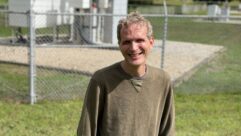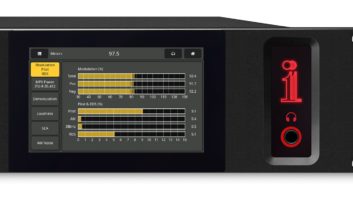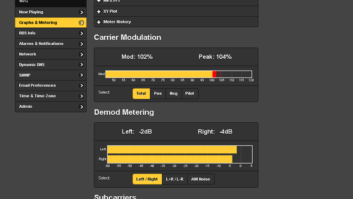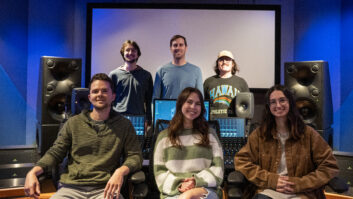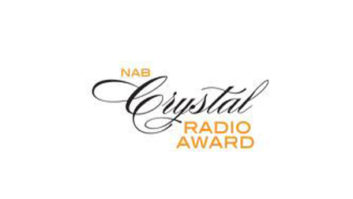
Tony Peterle
Tony Peterle, manager, WorldCast Systems Inc., comments as part of Radio World’s special series on tech trends in modulation monitor design.
How has monitoring gear changed?
Peterle: One word: plastics!
Actually the word is “digital,” of course. Monitoring gear has become smarter, more agile and more connected in every way imaginable. Not to mention the proliferation of new digital broadcast formats all over the world, and monitoring for things like streaming audio, podcasts, cable and other alternate delivery methods. We have more signals and services to monitor, while at the same time the economy has been forcing reductions in staff and equipment budgets.
Fortunately, modern monitors are stepping up to the task, monitoring multiple frequencies and formats automatically with a single unit has become much more commonplace, and our ever-more-ubiquitous network access means that we can connect to our devices on demand — and have the devices contact us, when something is amiss, anywhere and anytime.
We’re also seeing smarter devices that can perform multiple functions, so a single monitor can not only keep track of the four hybrid IBOC signals you have in a given market, it can also act as a remote control device for other equipment at the site. And high-performance DSP technology has allowed development of audio and FM test equipment with extraordinary precision and ease of use.
What is the state of the art?
Peterle: State of the art would be the “set it and forget it” kind of monitor. Something the user can put in place, make some simple adjustments to establish nominal performance levels and then completely ignore. The user can trust that their monitor is keeping track of everything, 24/7, and will let them know if any parameter is out of tolerance. …
As with all electronics, the market is moving towards smaller, more affordable units with even greater capabilities. Primary among them is autonomy — the ability to detect, and in some cases even correct, a problem without need for human intervention. Blending of monitoring and remote control functions is a natural step towards the concept of autonomous, “self-healing” sites. Mobile test and measurement gear has a whole new Frankenstinian thing going on now with the explosion of mobile computers — smart phones, tablets, etc. — that allow an equipment designer to focus just on the sensor package and the interface, and do all the raw computing and display generation with an off-the-shelf device.
I expect we’ll see more broadcast products exploiting this available processing power.
What unique problems are generated by HD Radio and RDS?
Peterle: When we first were shipping our Goldeneagle HD, we heard from a lot of early IBOC adopters that their heritage analog modulation monitors were not tolerating the HD signals well, and were showing inaccurate readings. This was of course before the power increase, the IBOC sidebands introduced a lot of new energy into the spectrum, and the analog filtering in the older mod monitors couldn’t block it out well enough. We were able to address that point in the Goldeneagle with a digital demodulator, to more precisely separate the analog signals from the energy in the IBOC carriers.
Since then, other than some issues with interference, HD Radio has posed no significant problems to monitoring and control; but there is a bit more of that to be done, with new or additional transmitters and other gear being added to each site as it goes digital. Now stations are offering data services using the IBOC bandwidth, so monitoring the quality and continuity of the data broadcasts is increasingly important.
Similarly, RDS it does not pose any significant problems to monitoring, it just increases the workload a bit. Traffic data (TMC) broadcasts on RDS have become much more common in U.S. markets, GSSNET is rolling out their first responder/homeland security alerting system using RDS, lots of stations are now paying attention to RT+ broadcasts, cell phone companies have announced their commitment to support and enable the FM receiver chips, which will expand the market for RT+ and other RDS/smart phone communications.
What do you have that’s new?
Peterle: Our Modulation Analyzer. It is one lightweight unit that can test and measure everything in the FM broadcast chain from audio to RF. It’s freaky scary powerful, to the point where we only need one analog filter — on the RF input, limiting it to the FM broadcast band. All of the other filtering, frequency selection and measurements are done in the digital domain, with incredible accuracy. Plus, it’s smart enough that the user can program a whole series of tests to be run in sequence — like a frequency response sweep of a transmitter, for example — and walk away. The Modulation Analyzer will run all of the tests autonomously, and when the user returns they can see the results and automatically generate a printed report with the data and graphic displays.
Anything else we need to know?
Peterle: Other than next week’s lottery numbers or Jennifer Aniston’s phone number, I can’t think of anything. In fact, now I really can’t think of anything.




